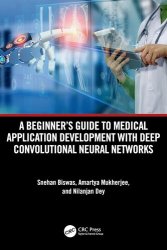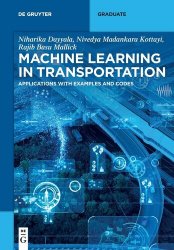 Название: A Beginner's Guide to Medical Application Development with Deep Convolutional Neural Networks
Название: A Beginner's Guide to Medical Application Development with Deep Convolutional Neural NetworksАвтор: Snehan Biswas, Amartya Mukherjee, Nilanjan Dey
Издательство: CRC Press
Год: 2025
Страниц: 199
Язык: английский
Формат: pdf (true), epub
Размер: 51.9 MB
This book serves as a source of introductory material and reference for medical application development and related technologies by providing the detailed implementation of cutting-edge Deep Learning methodologies. It targets cloud-based advanced medical application developments using open-source Python-based Deep Learning libraries. It includes code snippets and sophisticated convolutional neural networks to tackle real-world problems in medical image analysis and beyond.
In recent years, deep neural networks (DNNs) have emerged as a powerful tool for analyzing medical data. These networks are capable of learning complex patterns in data, and can be trained to identify subtle features that traditional methods may miss. With the ability to process large amounts of data quickly and accurately, DNNs offer a promising avenue for improving medical diagnosis and treatment.
This book aims to provide a comprehensive introduction to the use of DNNs for medical data analysis. The book is intended for a wide audience, including healthcare professionals, data scientists, researchers, and students. It covers the basics of neural networks and deep learning, and provides a detailed overview of the various types of networks that can be used for medical data analysis. The book also includes case studies and practical examples of how DNNs have been used to diagnose and treat a range of medical conditions.
Chapter 1 provides an overview of the basics of neural networks and Deep Learning. It covers the fundamentals of how neural networks work and how they can be used to learn from data. The chapter also explores different types of Deep Learning architectures and how they can be used for medical data analysis.
Chapter 2 focuses on the details about a special type of neural network, known as the convolutional neural network (CNN), and how it can solve the problems of image analysis by learning different features of the training images. The chapter also provides an idea about some of the recent state-of-the-art models that have been developed by researchers all around the world.
Chapter 3 explores how a sophisticated CNN can be designed using Python for solving the recognition of pneumonia category using chest X-ray images dataset. The chapter deals with details about the dataset preparation along with the designing of the CNN using Tensorflow library and OpenCV-Python.
Chapter 4 focuses on the use of DNNs for personalized medical imagery data analysis on a small scale. The main objective of this chapter is to guide the readers in solving small-scale image recognition problems using customized feature extractor along with traditional Machine Learning algorithms. We have demonstrated the usage of a state-of-the-art model known as the VGG model as the feature extractor along with a random forest classifier.
Chapter 5 covers the ethical considerations involved in designing an ensemble system of CNNs that will solve the task of recognizing malarial cell images. The chapter presents in detail about the dataset creation and the techniques of image data tensor formation; the CNNs have been designed using Tensorflow and Keras from scratch.
Chapter 6 guides the readers in understanding the complicated concept of Deep Learning by using a very easy approach. The chapter deals with what a CNN learns during its training and also the designed system is incorporated with an auto-encoder. This chapter presents the problem of performing medical image data reconstruction and hence during this process the learned features of the CNN are visualized. The chapter helps the readers in creating the code for the system from scratch.
Chapter 7 tackles an advanced problem in Deep Learning, the concept of image super resolution in medical domain. The chapter helps the readers in understating a sophisticated neural network system known as Super Resolution Generative Adversarial Neural Network (SR-GANN), via simple code snippets written in Python. The system data creation for training is also designed using Python from scratch.
In conclusion, this book provides a comprehensive introduction to the use of CNNs for medical data analysis. It covers the basics of neural networks and Deep Learning, and provides a detailed overview of the different types of networks that can be used for medical data analysis. The book includes case studies and practical examples of how CNNs have been used to diagnose and treat a range of medical conditions. The book highlights the potential of using DNNs for medical data analysis and how it can revolutionize the way we diagnose and treat diseases. Chapters in the book cover topics such as CNNs for image analysis, personalized medical imagery data analysis, ethical considerations, and advanced problems in Deep Learning.
Features:
Provides programming guidance for creation of sophisticated and reliable neural networks for image processing.
Incorporates the comparative study on GAN, stable diffusion, and its application on medical image data augmentation.
Focuses on solving real-world medical imaging problems.
Discusses advanced concepts of deep learning along with the latest technology such as GPT, stable diffusion, and ViT.
Develops applicable knowledge of deep learning using Python programming, followed by code snippets and OOP concepts.
This book is aimed at graduate students and researchers in medical data analytics, medical image analysis, signal processing, and Deep Learning.
Скачать A Beginner's Guide to Medical Application Development with Deep Convolutional Neural Networks
[related-news] [/related-news]
Комментарии 0
Комментариев пока нет. Стань первым!















